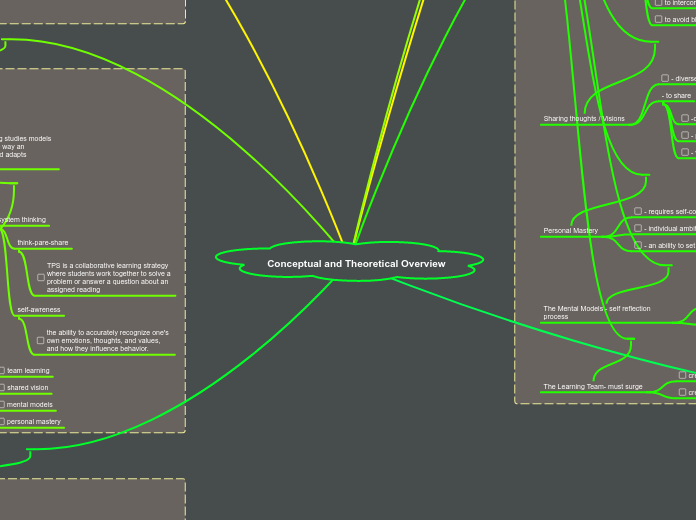Conceptual and Theoretical Overview
Concepts&Approaches
Humanist Apporach
- human needs must be provided to nourish an environment to confront challenges during the transition. O`Hara (1996)
Corporative/Collaborative Approach
- collective aspiration is important how to continually to learn to achieve collaborative learning environment. Peter Sange (1990)
- a successful transition can be accomplished by empowering individuals and organization through collaborative learning process. Watking&Marsich (1994)
Traditional Perception
McKinsey 7-S Framework
Hard Elements
Strategy
Structure
System
Soft Elements
Shared Values
Skills
Style
Staff
Characteristics of Learning Organization
Systems Thinking
to appreciate patterns
realization as an alternative of isolated events
the actions taken during operations.
to make active a learning organization
realization
to interconnect the entire team
to avoid blaming each other
Sharing thoughts / Visions
- diverse visionary is promoted
- to share
-original ideas
- proposals
- visions
Personal Mastery
- requires self-commitment
- individual ambition and devotion
- an ability to set a realistic goals
The Mental Models - self reflection process
-generalization of models
- structuring models
The Learning Team- must surge
credibility
creativity
Characteristic relationships
structure
reporting lines
roles and accountabilities
governance structures
partnerships
geographic footprint
people
leadership
skills
values and culture
workforce planning
process
decision making
end-to-end business processes
cross-functional linkages
performance and knowledge-management system
Conclusion
to achieve a continuous development and transition
the progress of learning of its members` burden must be smoothened
Create or attach
checklist
tasks
tasks
tasks
Learning Organization
Definition
Organizational learning studies models and theories about the way an organization learns and adapts
- Bob Fox
The five disciplines/characteristics
system thinking
think-pare-share
TPS is a collaborative learning strategy where students work together to solve a problem or answer a question about an assigned reading
self-awreness
the ability to accurately recognize one's own emotions, thoughts, and values, and how they influence behavior.
team learning
shared vision
mental models
personal mastery
Change and Innovation
changing poses new challenges to individuals
innovation trigger organizations to adapt to new circumstances
business model innovation
educational model innovation
pedagogical innoveaiont
learning technologies
21st Century Skill
types of innovation
